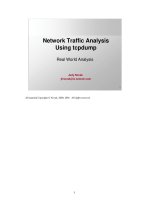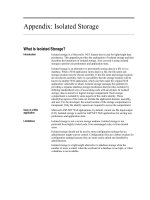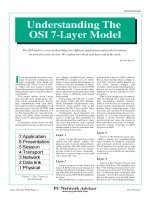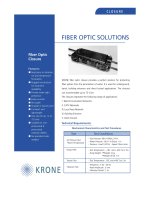Tài liệu TestKiller 640-504 Ed2 doc
Bạn đang xem bản rút gọn của tài liệu. Xem và tải ngay bản đầy đủ của tài liệu tại đây (240.25 KB, 30 trang )
CISCO
STUDY GUIDE
Building Cisco Multilayer
Switched Networks (BCMSN)
640-504
Edition 2
Congratulations!!
You have purchased a Testkiller, Ltd Study Guide.
This study guide is a selection of keypoints you will need to know to pass
the official CCNP 640-504 Switching exam. Study and memorize the fol-
lowing concepts, keypoints and problems for approximately 15 to 20 hours
and you will be prepared to take the exams. We guarantee it!
Remember, average study time is 15 to 20 hours and then you are ready!!!
GOOD LUCK!
DISCLAIMER
This study guide and/or material is not sponsored by, endorsed by or affiliated with Cisco
Systems, Inc. Cisco®, Cisco Systems®, CCDA™, CCNA™, CCDP™, CCNP™,
CCIE™, CCSI™, the Cisco Systems logo and the CCIE logo are trademarks or registered
trademarks of Cisco Systems, Inc. in the United States and certain other countries. All
other trademarks are trademarks of their respective owners
.
Guarantee
If you use this study guide correctly and still fail the exam, send your official
score notice and mailing address to:
Testkiller, Ltd
8200 Pat Booker Rd. #368
San Antonio, TX 78233
We will gladly refund the cost of this study guide. However, you will not
need this guarantee if you follow the above instructions.
This material is protected by copyright law and international treaties. Un-
authorized reproduction or distribution of this material, or any portion
thereof, may result in severe civil and criminal penalties, and will be prose-
cuted to the maximum extent possible under law.
Copyright 2001 Testkiller, Ltd. All Rights Reserved.
Table of Contents
Overview of a Campus Network......................................................................................... 1
A Solution to Broadcast Domain Issues: Localize Traffic ............................................. 1
Current Campus Networks.............................................................................................. 1
The 80/20 Rule................................................................................................................ 1
The New 20/80 Rule ....................................................................................................... 1
The Emerging Campus Network .................................................................................... 2
Emerging Campus Structure........................................................................................... 2
The Hierarchical Model .................................................................................................. 2
The Access Layer........................................................................................................ 2
The Distribution Layer................................................................................................ 3
The Core Layer ........................................................................................................... 3
The Building Block Approach........................................................................................ 3
Connecting the Switch Block.......................................................................................... 3
Cable Media Types ............................................................................................................. 3
Ethernet........................................................................................................................... 4
Fast Ethernet ...................................................................................................................4
Cabling Switch Block Devices ....................................................................................... 4
Configuring Connectivity within the Switch Block........................................................ 4
Defining Common Workgroups with LANs....................................................................... 4
Layer2 Campus Network ................................................................................................ 4
VLANs............................................................................................................................ 5
Defining VLAN Boundaries....................................................................................... 5
Link Types .................................................................................................................. 5
VLAN Frame Identification Methods......................................................................... 5
Configuring a Trunk Link........................................................................................... 6
VTP Modes of Operation................................................................................................ 6
Managing Redundant Links................................................................................................ 7
Contents of BPDU .......................................................................................................... 7
Spanning-Tree Port States............................................................................................... 7
Inter-VLAN Routing....................................................................................................... 7
Improving IP Routing Performance with Multilayer Switching......................................... 8
MLS Components ........................................................................................................... 8
Creating a NULL Domain .............................................................................................. 8
Configuring HSRP for Fault Tolerance Routing ................................................................ 8
Routing Issues in a Redundant Environment.................................................................. 8
HSRP Group Members ............................................................................................... 9
HSRP States................................................................................................................ 9
Multicast Overview..................................................................................................... 9
Controlling Access to the Campus Network....................................................................... 9
Applying Policies in a Hierarchical Model..................................................................... 9
Managing Network Devices ......................................................................................... 10
Port Security.................................................................................................................. 10
www.testkiller.com
GFI - Security & Communication tools for NT/2000: FAXmaker fax server software, Mail essentials email con-
tent checking & anti-virus software and LANguard network security software. />
1
Key Concepts
Building Cisco Multilayer Switched Networks
Overview of a Campus Network
A campus is a building or group of buildings connected into one enterprise network that
consists of many LANs. A campus is further defined as a company or a portion of a com-
pany contained in a fixed geographic area. The major problem with traditional networks
is availability and performance. These two problems are impacted by the amount of
bandwidth in the network.
A Solution to Broadcast Domain Issues: Localize Traffic
There are two main options for addressing the broadcast containment issue for large
switched LAN sites. The first option is to use routers to create many subnets, logically
segmenting the traffic. LAN broadcasts do not pass through routers. The second option is
to implement virtual LANs (VLANs) within the switched network.
Current Campus Networks
Most campus networks now consists of two components:
1. LAN switches
2. Routers
The 80/20 Rule
Ideally the end users with common interests or work patterns are placed in the same logi-
cal network as the servers they access most often. The 80/20 rule states that in a properly
designed network environment 80% of the traffic on a given network segment is local.
Not more than 20% of the network traffic should move across the backbone. Backbone
congestion indicates that the traffic patterns are not meeting the 80/20 rule.
The New 20/80 Rule
Traffic patterns are moving toward what is now referred to as the 20/80 model. In the
20/80 model only 20% of traffic is local to the workgroup LAN and 80% of the traffic is
required to go off the local network.
www.testkiller.com
GFI - Security & Communication tools for NT/2000: FAXmaker fax server software, Mail essentials email con-
tent checking & anti-virus software and LANguard network security software. />
2
The Emerging Campus Network
The key requirements placing pressure on the emerging campus designs are as follows:
• Fast convergence
• Deterministic paths
• Deterministic failover
• Scalable size and throughput
• Centralized applications
• The new 20/80 Rule
• Multiprotocol support
• Multicasting
Emerging Campus Structure
Services can be separated into three separate categories:
1. Local services
2. Remote services
3. Enterprise services
The Hierarchical Model
The layers within the hierarchical model are defined as follows:
1. Access layer
2. Distribution layer
3. Core layer
The Access Layer
Some of the functions represented by Access layer are Shared bandwidth, Switched
bandwidth, and Layer 2 services.
www.testkiller.com
GFI - Security & Communication tools for NT/2000: FAXmaker fax server software, Mail essentials email con-
tent checking & anti-virus software and LANguard network security software. />
3
The Distribution Layer
The multitude functions of the Distribution layer are as follows:
• VLAN aggregation
• Department of workgroup access
• Broadcast or multicast domain functions
• Inter-VLAN routing
• Media translation
• Security
The Core Layer
The core layer is responsible for providing connectivity between switched blocks, provid-
ing access to other blocks, such as the WAN block, and switching frames or packets as
quickly as possible.
The Building Block Approach
The two major elements for a campus network are Switch block and Core block. These
include three contributing variables:
• Server block
• WAN block
• Mainframe block
Connecting the Switch Block
Campus networks carry a variety of traffic types. As more applications and users are con-
figured into the campus network, the need for available bandwidth increases.
Cable Media Types
A variety of cable media types have been deployed for local-area networks, including
Ethernet, Token Ring and FDDI. In order to increase the overall performance to the us-
www.testkiller.com
GFI - Security & Communication tools for NT/2000: FAXmaker fax server software, Mail essentials email con-
tent checking & anti-virus software and LANguard network security software. />
4
ers, you must either increase the overall bandwidth of the network, or decrease the num-
ber of devices on the same shared media cable segment.
Ethernet
One solution to the bandwidth crunch is Ethernet Switching, which dynamically allocates
dedicated 10 Mbps connections to each user on the network.
Fast Ethernet
For campuses with existing Ethernet installations, increasing the network speed from 10
Mbps to 100 Mbps is preferable to investing in a completely new LAN technology.
Cabling Switch Block Devices
There are two basic types of cable connections:
1. through the console port
2. through the Ethernet port
Configuring Connectivity within the Switch Block
After the switches have been physically cabled, some basic system settings that should be
assigned are:
• Limiting access to the switch
• Setting the host or prompt name to the switch
• Defining the switch’s IP address and subnet mask
• Identifying a port or an interface with a unique description
• Setting the port speed
• Defining the full duplex port
• Verifying connectivity
Defining Common Workgroups with LANs
Layer2 Campus Network
www.testkiller.com
GFI - Security & Communication tools for NT/2000: FAXmaker fax server software, Mail essentials email con-
tent checking & anti-virus software and LANguard network security software. />
5
With Layer2 campus networks you encounter problems of flat network structures, secu-
rity management, and managing multiple paths to a destination.
VLANs
VLANs solve many of the issues of the Layer2 Network by allowing efficient bandwidth
utilization, security management, load-balancing multiple paths, and the isolation of
problem components.
Defining VLAN Boundaries
The number of VLANs in the switch block will vary widely depending on several factors.
These factors include traffic patterns, types of applications, network management needs
and group commonality.
When scaling VLANs in the switch block, there are two basic methods of defining the
VLAN boundaries:
1. End-to-end VLANs
2. Local VLANs
Link Types
There are three basic VLAN link types:
1. Access Links
2. Trunk Links
3. Hybrid Links
VLAN Frame Identification Methods
There are four basic Frame ID methods:
1. Inter-switch link (ISL)
2. IEEE 802.1Q
3. LAN Emulation (LANE)
4. 802.10
www.testkiller.com
GFI - Security & Communication tools for NT/2000: FAXmaker fax server software, Mail essentials email con-
tent checking & anti-virus software and LANguard network security software. />
6
Fields in an ISL encapsulation:
• Destination Address (DA)
• Frame Type (TYPE)
• User-defined Bits (USER)
• Source address (SA)
• Length (LEN)
• SNAP/LLC
• High bits of the source address (HSA)
• VLAN ID
• BPDU/CDP indicator
• Index (INDX)
• Reserved for FDDI and Token Ring
• Encapsulated Frame
• Frame Check Sequence
Configuring a Trunk Link
Fast Ethernet and Gigabit Ethernet trunking can be set up in any of the following modes:
• On
• Off
• Desirable
• Auto
• Nonegotiate
VTP Modes of Operation
There are three VTP modes of operation:
1. Server
www.testkiller.com
GFI - Security & Communication tools for NT/2000: FAXmaker fax server software, Mail essentials email con-
tent checking & anti-virus software and LANguard network security software. />
7
2. Client
3. Transparent
Managing Redundant Links
The basic functionality of a switch is identical to that of a transparent bridge. By defini-
tion a bridge must not modify the frames that it forwards. A bridge learns addresses by
listening on a port for a device’s source MAC address. The bridge then forwards the
broadcast it receives out all ports except for the port that initially received the broadcast.
If a destination MAC address is unknown, sometimes called an unknown unicast, the
bridge forwards the frame out all ports except for the port that initially received the
frame. When a bridge receives a frame, it either filters it if the frame’s destination is out
the receiving port, or forwards the frame if the destination is on a different port.
Contents of BPDU
The BPDU contains the following information:
• Root information
• Path cost
• Bridge information
• Port information
• Timers
Spanning-Tree Port States
There are five types of Spanning Tree Port states:
1. Blocked
2. Listen
3. Learn
4. Forward
5. Disabled
Inter-VLAN Routing
www.testkiller.com
GFI - Security & Communication tools for NT/2000: FAXmaker fax server software, Mail essentials email con-
tent checking & anti-virus software and LANguard network security software. />
8
In Isolated Broadcast Domains you need to consider sharing resources between VLANs,
load-balancing, redundant Links, addressing, and segmenting networks with VLANs.
Improving IP Routing Performance with Multilayer Switching
MLS Components
Multilayer switching includes the following three components:
1. Multilayer Switching Switch Engine (MLS-SE)
2. Multilayer Switching Route Processor (MLS-RP)
3. Multilayer Switching Protocol (MLSP)
Creating a NULL Domain
There are several ways in which a route processor and a switch can end up in different
VTP domains. You can purposely place both devices in separate domains, you can mis-
name or mistype the VTP domain when configuring either the switch or the route proces-
sor, or you can enter the MLS interface command prior to putting the interface in a VTP
domain.
Configuring HSRP for Fault Tolerance Routing
The Hot Standby Routing Protocol provides fault tolerance and enhanced routing per-
formance for IP networks. HSRP allows Cisco IOS routers to monitor each other’s opera-
tional status and very quickly assume packet forwarding responsibility in the event that
the current forwarding device in the HSRP group fails or is taken down for maintenance.
Routing Issues in a Redundant Environment
Hosts learn which router they should use by the following methods:
• Default gateway
• Proxy ARP
• Routing protocol
www.testkiller.com
GFI - Security & Communication tools for NT/2000: FAXmaker fax server software, Mail essentials email con-
tent checking & anti-virus software and LANguard network security software. />
9
HSRP Group Members
The stand by group is comprised in the following entities:
• One active router
• One stand by router
• One virtual router
• Other routers
HSRP States
The HSRP states include:
• Initial state
• Learn state
• Listen state
• Speak state
• Standby state
• Active state
Multicast Overview
Multimedia traffic can work its way through the network using one of the following
methods:
• Unicast
• Broadcast
• Multicast
Controlling Access to the Campus Network
Access control cannot be implemented until a standard access policy has been created.
Applying Policies in a Hierarchical Model









